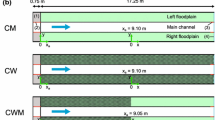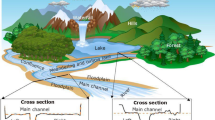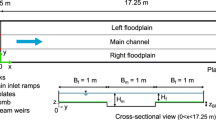Abstract
Channel–shoal patterns are often observed in the back–barrier basins of inlet systems and are important from both an economical and ecological point of view. Focussing on double–inlet systems, the initial formation of these patterns is investigated using an idealized model. The model is governed by the depth–averaged shallow water equations, a depth–integrated concentration equation and a tidally–averaged bottom evolution equation. Focussing on rectangular basins and neglecting the effects of earth rotation, it is found that laterally uniform morphodynamic equilibria can become linearly unstable, resulting in initial patterns that resemble channels and shoals. When the water motion is only forced by an M2 tidal constituent, the existence of (laterally uniform) morphodynamic equilibria for which both inlets are connected strongly depends on the relative phase and amplitudes of the tidal forcing. If such equilibria exist, they can be either stable against small perturbations or linearly unstable. If these equilibria are linearly unstable, two instability mechanisms can be identified, the first related to the convergences and divergences of diffusive transports, the second mechanism related to a combination of advective and diffusive transports. In the former case, all eigenvalues are real and the bedforms grow exponentially in time. In the latter case, the eigenvalues are complex, resulting in bedforms that both migrate and grow in time. In case external overtides and a time–independent discharge are included, no diffusive instabilities are found anymore for the parameters considered in this paper. This implies that all instabilities are migrating in time. In all cases considered, the bed perturbations have only an appreciable amplitude at locations where the underlying laterally uniform equilibrium has a local minimum in water depth. This is consistent with observations from numerical models and laboratory experiments.









Similar content being viewed by others
References
Csanady GT (1982) Circulation in the Coastal Ocean, Reidel, Boston
D’Alpaos A, Lanzoni S, Marani M, et al. (2007) Landscape evolution in tidal embayments: modelling the interplay of erosion, sedimentation, and vegetation dynamics. J Geophys Res 112:F01,008
Dalrymple R W, Rhodes R N (1995) Chapter 13 estuarine dunes and bars. In: Perillo G (ed) Geomorphology and sedimentology of estuaries, developments in sedimentology, vol 53. https://doi.org/10.1016/S0070-4571(05)80033-0. https://www.sciencedirect.com/science/article/pii/S0070457105800330. Elsevier, pp 359–422
De Swart H E, Zimmerman J T F (2009) Morphodynamics of tidal inlet systems. Ann Rev Fluid Mech 41:203–229
Deng X, Meerman C, Boelens T, et al. (2021) Morphodynamic equilibria in double–inlet systems: existence and stability. J Geophys Res 126:2021JF006,266
Duran-Matute M, Gerkema T, De Boer G J, et al. (2014) Residual circulation and freshwater transport in the dutch wadden sea: a numerical modelling study. Ocean Sci 10:611–632
Dyer K R (1986) Coastal and estuarine sediment transport. Wiley, Chichester, p 342
Falqués A, Montoto A, Iranzo V (1996) Bed–flow instability of the longshore current. Cont Shelf Res 15:1927–1964
Glaeser D J (1978) Global distribution of barrier islands in terms of tectonic setting. J Geol 86:283–297
Hepkema T, De Swart H, Schuttelaars H (2019) The sensitivity of tidal bar wavelength to channel width. J Geophys Res Earth Surf 124:2417–2436
Hibma A, De Vriend H J, Stive M J F (2003) Numerical modelling of shoal pattern formation in well-mixed elongated estuaries. Estuar Coast Shelf Sci 57:981–991
Hibma A, Schuttelaars H M, De Vriend H J (2004) Initial formation and evolution of channel-shoal patterns in estuaries. Cont Shelf Res 24:1637–1650
Israel C G, Dunsbergen D W (2000) Cyclic morphological development of the ameland inlet, the Netherlands. River, Coastal and Estuarine Morphodynamics 1:701–714
Krol M (1991) On the averaging method in nearly time-periodic advection-diffusion problems. SIAM J Appl Math 51:1622–1637
Leuven J, Kleinhans M (2019) Incipient tidal bar and sill formation. J Geophys Res: Earth Surface 124(7):1762–1781. https://doi.org/10.1029/2018JF004953
Lorentz H (1922) Het in rekening brengen van den weerstand bij schommelende vloeistofbewegingen. De Ingenieur, p 695
Marciano R, Wang Z, Hibma A, et al. (2005) Modeling of channel patterns in short tidal basins. J Geophys Res 110. https://doi.org/10.1029/2003JF000092
McBride R A, Byrnes M R, Hiland M W (1995) Geomorphic response-type model for barrier coastlines: a regional perspective. Mar Geol 126:143–159
Meerman C, Rottschäfer V, Schuttelaars H (2019) Influence of geometrical variations on morphodynamic equilibria in short tidal basins. Ocean Dyn 69(2):221–238. https://doi.org/10.1007/s10236-018-1236-7https://doi.org/10.1007/s10236-018-1236-7
Mulhern J, Johnson C, Martin J (2017) Is barrier island morphology a function of tidal and wave regime? Mar Geol 387:74–84. https://doi.org/10.1016/j.margeo.2017.02.016
Oost A P, Hoekstra P, Wiersma A, et al. (2012) Barrier island management: lessons from the past and directions for the future. Ocean Coast Manag 68:18–38
Pacheco A, Vila-Concejo A, Ferreira O, et al. (2008) Assessment of tidal inlet evolution and stability using sediment budget computations and hydraulic parameter analysis. Mar Geol 247:104–127
Ridderinkhof H (1988) Tidal and residual flows in the western Dutch Wadden sea i1: an analytical model to study the constant flow between connected tidal basins. Neth J Sea Res 22:185–198
Salles P, Voulgaris G, Aubrey D G (2005) Contribution of nonlinear mechanisms in the persistence of multiple tidal inlet systems. Estuar Coast Shelf Sci 65:475–491
Sanders JA, Verhulst F (1985) Averaging methods in nonlinear dynamical systems. Springer, New York
Sassi M, Duran-Matute M, Van Kessel T, et al. (2015) Variability of residual fluxes of suspended sediment in a multiple tidal-inlet system: the Dutch wadden sea. Ocean Dyn 65(9-10):1321–1333. https://doi.org/10.1007/s10236-015-0866-2. https://www.scopus.com/inward/record.uri?eid=2-s2.0-849423657%37&doi=10.1007%2fs10236-015-0866-2&partnerID=40&md5=74b84a90302a69c787d42d9fc0%ce8f0b
Schuttelaars H M, De Swart H E (1996) An idealized long-term morphodynamic model of a tidal embayment. Eur J Mech B/Fluids 15:55–80
Schuttelaars H M, De Swart H E (1999) Initial formation of channels and shoals in a short tidal embayment. J Fluid Mech 386:15–42
Schuttelaars H M, De Swart H E (2000) Multiple morphodynamic equilibria in tidal embayments. J Geophys Res 105:105–124
Seminara G, Bolla Pittaluga M, Tambroni N, et al. (2005) Open problems in modelling the long-term morphodynamic evolution of venice lagoon. Flooding and environmental challenges for Venice and its lagoon, pp 345–353
Stutz M L, Pilkey O H (2011) Open-ocean barrier islands: global influence of climatic, oceanographic, and depositional settings. J Coast Res 27:207–222
Tambroni N, Seminara G (2006) Are inlets responsible for the morphological degradation of venice lagoon? J Geophys Res: Earth Surface 111. https://doi.org/10.1029/2005JF000334. https://www.scopus.com/inward/record.uri?eid=2-s2.0-34147093357&doi=10.1029%2f2005JF000334&partnerID=40&md5=e8c4184e8ee04ee58bfe0449486c0b9b
Ter Brake M C, Schuttelaars H M (2010) Modeling equilibrium bed profiles of short tidal embayment. on the effect of the vertical distribution of suspended sediment and the influence of the boundary conditions. Ocean Dyn 60:183–204
Ter Brake M C, Schuttelaars H M (2011) Channel and shoal development in a short tidal embayment: an idealized model study. J Fluid Mech 677:503–529
Van der Spek A J F (1997) Tidal asymmetry and long-term evolution of holocene tidal basins in the netherlands: simulation of paleo-tides in the scheldt estuaries. Mar Geol 141:71–90
Van Leeuwen S M, De Swart H E (2001) The effect of advective processes on the morphodynamic stability of short tidal embayments. Phys Chem Earth (B) 26:735–740
Van Leeuwen S M, De Swart H E (2004) Effect of advective and diffusive sediment transport on the formation of local and global bottom patterns in tidal embayments. Ocean Dyn 54:441–451
Van der Wegen M, Roelvink J A (2008) Long-term morphodynamic evolution of a tidal embayment using a two-dimensional process-based model. J Geophys Res 7:C03,016. https://doi.org/10.1029/2006JC003983
Zimmerman J T F (1992) On the lorentz linearization of a nonlinearly damped tidal helmholtz oscillator. Proceedings KNAW 95:127–145
Author information
Authors and Affiliations
Corresponding author
Ethics declarations
Data sharing not applicable to this article as no datasets were generated or analysed during the current study.
This article is financially supported by the China Scholarship Council (nr. 201706890036).
Conflict of Interests
The authors report no conflict of interest.
Additional information
Responsible Editor: Christoph Voelker
Publisher’s Note
Springer Nature remains neutral with regard to jurisdictional claims in published maps and institutional affiliations.
Appendix A: Diffusively dominated transport
Appendix A: Diffusively dominated transport
The influence of the relative M2 phase, \({\Delta }\phi _{M_{2}}\), on the diffusively dominated morphodynamic equilibria is investigated. For simplicity, the undisturbed water depth at inlet I I is taken to be equal to 11.7 m, the same water depth as inlet I. All other parameter values are taken from Table 2. When the sediment transport is dominated by diffusion, the morphodynamic equilibrium condition reduces to
In a rectangular geometry, morphodynamic equilibria which are laterally uniform can be found using the bifurcation approach discussed in Deng et al. (2021). As an example, Fig. 10a shows the minimum water depths WD\(_{{\min \limits }}\) of these morphodynamic equilibria as a function of \({\Delta }\phi _{M_{2}}\) varying from − 60∘ to 60∘. It demonstrates that the existence of morphodynamic equilibria depends on the relative M2 phase: for \({\Delta }\phi _{M_{2}}\) between 10∘ to 16∘, no morphodynamic equilibrium is found for which both inlets are connected. For other relative M2 phases considered, there is always a 1D–stable equilibrium.
Laterally uniform morphodynamic equilibria for diffusively dominated transport. Panel (a) shows WD\(_{{\min \limits }}\) the minimum water depth of equilibrium bed profiles, with its location coded with color. Panel (b) shows the equilibrium bed profiles for three different values of \({\Delta }\phi _{M_{2}}\). The minimum water depths in the cases shown in panel(b) are indicated by cross-shaped markers in panel (a)
To investigate the linear stability of these 1D–stable morphodynamic equilibria to the perturbations with lateral structure, morphodynamic equilibria obtained with \({\Delta }\phi _{M_{2}}={19}^{\circ }\) (orange), \({\Delta }\phi _{M_{2}}={20}^{\circ }\) (green) and \({\Delta }\phi _{M_{2}}={25}^{\circ }\) (red) are examined. Their bed profiles are shown in Fig. 10b. These three equilibrium bed profiles correspond to WD\(_{{\min \limits }}\) indicated by crosses (with colors associated to their bed profiles) in Fig. 10a. The largest dimensionless growth rate R(ω) of these three morphodynamic equilibria as a function of dimensionless wave number ln is shown in Fig. 11a. It shows that at ln = 0 the largest dimensionless growth rate R(ω) is negative for all three selected \({\Delta }\phi _{M_{2}}\), which shows these three morphodynamic equilibria are 1D–stable. Increasing the dimensionless wave number ln from 0 to 1200, the largest dimensionless growth rate R(ω) for \({\Delta }\phi _{M_{2}}={19}^{\circ }\) first increases, till a maximum is obtained at approximately ln = 560, and then decreases to become negative for \(l_{n}\sim 1200\). Positive R(ω) indicates that the laterally uniform morphodynamic equilibrium for \({\Delta }\phi _{M_{2}}={19}^{\circ }\) is unstable against perturbations with a lateral structure. Unlike \({\Delta }\phi _{M_{2}}={19}^{\circ }\), the largest dimensionless growth rate R(ω) for \({\Delta }\phi _{M_{2}}={25}^{\circ }\) is negative for all ln considered, which indicates the corresponding equilibrium is stable against perturbations with lateral structure. The critical value of the relative M2 phase, \({\Delta }\phi _{M_{2}}\), that seperates stable and unstable morphodynamic equilibrium against perturbations with lateral structure, is \({\Delta }\phi _{M_{2}}={20}^{\circ }\) (see also Fig. 14).
When using width B = 6 km, the dimensionless wave number ln = 555.9, at which R(ω) for \({\Delta }\phi _{M_{2}}={19}^{\circ }\) reaching a maximum, corresponds to a mode number n = 18. The bed patterns hn for n = 18 (ln = 555.9) are shown in Fig. 11c. Compared with the bed patterns for n = 0 shown in Fig. 11b, the bed patterns for n = 18 are more localized, i.e., the bed patterns for n = 18 are nonzero within a region of approximately 15km, while the bed patterns for n = 0 are nonzero everywhere between the two inlets. Figure 11c also shows that the bed patterns for n = 18 are close to where WD\(_{{\min \limits }}\) is found. The morphodynamic equilibrium for \({\Delta }\phi _{M_{2}}={19}^{\circ }\) is called diffusively unstable, since only diffusive transport plays a role.
To study the instability mechanism in detail, the classical diffusive transport \(<\!\!{\mathbf {F}^{00}_{\text {diff}}}\!\!>\), the topographically induced diffusive transport \(<\!\!{\mathbf {F}^{00}_{\text {topo}}}\!\!>\) and the total transport < F > of the first 1 km in lateral direction for \({\Delta }\phi _{M_{2}}={19}^{\circ }\) and mode number n = 0 are shown in Fig. 12a, c and e, while those for \({\Delta }\phi _{M_{2}}={19}^{\circ }\) and mode number n = 18 are shown in Fig. 12b, d and f, respectively. These figures show that the topographically induced diffusive transport \(<\!\!{\mathbf {F}^{00}_{\text {topo}}}\!\!>\) is directed from crests to troughs and stablizes the bottom pattern, while the classical diffusive transport \(<\!\!{\mathbf {F}^{00}_{\text {diff}}}\!\!>\) is generally directed from troughs to crests and destablizes the bottom patterns. These two diffusive transport result in a total transport < F >, which can be either directed from crests to troughs (n = 0) or from troughs to crests (n = 18), depending on the mode number n, as well as the relative M2 phase. When mode number n = 0, these three sediment transports flow in a longitudinal direction, since there is no lateral structure, while these transports flow laterally when mode number n = 18.
Bottom patterns of laterally uniform morphodynamic equilibria for diffusively dominated transport. Panels (a), (c) and (e) show the bottom patterns for \({\Delta }\phi _{M_{2}}={19}^{\circ }\) and n = 0, with white areas representing crests and dark areas representing troughs. The arrows indicate the direction and relative magnitude of classical diffusive flux \(<\!\!{\mathbf {F}^{00}_{\text {diff}}}\!\!>\), the topographically induced diffusive flux \(<\!\!{\mathbf {F}^{00}_{\text {topo}}}\!\!>\) and the total flux < F >. Panels (b), (d) and (f) show the same but for \({\Delta }\phi _{M_{2}}={19}^{\circ }\) and n = 18
The instability mechanism can also be studied using the divergences of these three sediment fluxes, which have the same lateral structure as their corresponding bottom pattern. Figure 13a shows these divergences in the longitudinal direction at y = 0 for \({\Delta }\phi _{M_{2}}={19}^{\circ }\) and mode number n = 0, together with the corresponding bottom pattern, while the ones for \({\Delta }\phi _{M_{2}}={19}^{\circ }\) and mode number n = 18 are shown in Fig. 13b. From these figures it follows that the divergence of the classical diffusive transport \(<\!\!{\mathbf {F}^{00}_{\text {diff}}}\!\!>\) enhances perturbations of bottom patterns, and the divergence of topographically induced diffusive transport \(<\!\!{\mathbf {F}^{00}_{\text {topo}}}\!\!>\) reduces the amplitudes of the perturbations. These two sediment transports almost balance each other, resulting in a divergence of the total transport < F > with smaller magnitude. When mode number n = 0 is considered, < F > transports sediment from troughs to crests, while for mode number n = 18, < F > transports sediment from crests to troughs.
Divergences of sediment fluxes. Panel (a) shows the divergences of the sediment fluxes for \({\Delta }\phi _{M_{2}}={19}^{\circ }\) and mode number n = 0 at y = 0, together with the corresponding bottom pattern. Panel (b) shows the same but for \({\Delta }\phi _{M_{2}}={19}^{\circ }\) and mode number n = 18
The existence and stability of laterally uniform morphodynamic equilibria depends not only on the relative M2 phase but also on the M2 amplitude at inlet I I, which is shown in Fig. 14. In this figure, the region in parameter space where no laterally uniform morphodynamic equilibrium exists, is indicated by the white color. Linearly stable equilibria are found in the black colored area, while linearly unstable equilibria (resulting from the diffusive mechanism) in the light gray colored area.
Existence and linear stability of stable laterally uniform morphodynamic as a function of the M2 tidal amplitude at inlet II and the raltive phases when dominated by diffusive transport. The white, black, dark region indicate where no, linearly stable, diffusively unstable morphodynamic equilibria are found. If the underlying equilibrium is unstable, the mechanism resulting in the largest positive growth rate is used as indicateive of the instability mechanism. The crosses indicate the experiments discussed in detail in this Appendix A
Rights and permissions
Springer Nature or its licensor holds exclusive rights to this article under a publishing agreement with the author(s) or other rightsholder(s); author self-archiving of the accepted manuscript version of this article is solely governed by the terms of such publishing agreement and applicable law.
About this article
Cite this article
Deng, X., De Mulder, T. & Schuttelaars, H. Initial formation of channel–shoal patterns in double–inlet systems. Ocean Dynamics 73, 1–21 (2023). https://doi.org/10.1007/s10236-022-01528-6
Received:
Accepted:
Published:
Issue Date:
DOI: https://doi.org/10.1007/s10236-022-01528-6









